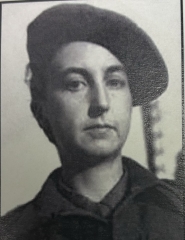Pearl Witherington

Pearl Witherington
PEARL
WITHERINGTON
SOLDIER DETAILS
Legion of Honour
BIOGRAPHY
Cecile Pearl Witherington was born and raised in France by British expatriate parents, and was a British subject. Witherington escaped from occupied France with her mother and three sisters in December 1940. The family arrived in London in July 1941 where she found work with the Air Ministry, specifically the Women's Auxiliary Air Force. Determined to fight back against the German occupation of France, and wanting a more active role in the fight, she joined Britain's Special Operations Executive (SOE) on 8 June 1943. In training she emerged as the "best shot" the service had ever seen; however, she never carried a gun during her mission in France. Given the code name "Marie", Witherington was dropped by parachute into occupied France on 22 September 1943, landing near Tendu in Indre Department. There she joined Maurice Southgate, leader of the SOE Stationer Network and Jacqueline Nearne, Southgate's courier, and reunited with her fiancé. Over the next eight months, posing as a cosmetics saleswoman, Witherington also worked as a courier The Stationer network covered a large area in central France and Witherington was effectively homeless, spending nights sleeping on trains as she traveled from one place to another delivering messages and undergoing frequent checks of her (false) identity cards by the Gestapo and French police. In April of 1944, Nearne was arrested and Southgate in May of 1944, was arrested. Their wireless operator arrested a day later. Witherington escaped being caught. Survival as an SOE agent was often luck. With her cohorts captured, Witherington formed and became leader of a new SOE network, Wrestler, under the new code-name "Pauline", in the Valençay–Issoudun–Châteauroux triangle. She organized the network with the help of her fiancé, Henri Cornioley. Witherington did not attempt to issue orders to the maquis groups directly, but found a willing French colonel to do so. Witherington worked closely with the adjoining SOE Shipwright network, headed by her former colleague Amédée Maingard. Together, their networks caused more than 800 interruptions of railway lines in June 1944 focused on cutting the main railroad line between Paris and Bordeaux. Putting those lines out of operation hindered the German effort to transport men and material to the battle front in Normandy. On the morning of 11 June 1944, German soldiers attacked Witherington at the Les Souches château, her headquarters near the village of Dun-le-Poëlier. Only a few maquis and non-combatants were present when the Germans arrived. Under fire, Witherington hid the tin where she kept a large amount of money and fled to a wheat field where she hid until nightfall. Her fiancé, Henri Cornioley, also hiding in a wheat field, counted 56 truckloads of Germans participating in the operation. According to Witherington, the Germans didn't try to find the hidden maquis and the SOE agents, confining themselves to destroying the weapons they found in the chateau. The attack on Witherington's headquarters was part of a larger operation in which 32 maquis were killed. The attack left Witherington in "a hopeless state—we had nothing left, no weapons and no radio." She bicycled to Saint-Viâtre to meet an SOE operative, Philippe de Vomécourt, nom de guerre "Saint Paul," and radioed London requesting resupply. On 24 June, three planes air-dropped supplies and Witherington was back in operation. The number of maquis in her region quickly ballooned to as many as 3,500 as the Normandy invasion emboldened young men to join the resistance. She and Cornioley divided the maquis into four subsections, each with its leader. SOE in Great Britain supported the maquis groups by parachuting 60 planeloads of arms and material to them. Witherington had long requested a military commander to help her and on 25 July Captain Francois Perdriset arrived to assist in the military operations of the maquis in Witherington's sector. Witherington returned to England in September of 1944 and married Henri Comioley. She was eligible to receive the Military Cross but it was not extended to women at the time. Courtesy of Second World War-Secret Service and Wikipedia.org.
 Eisenhower Foundation
Eisenhower Foundation
